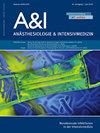新冠肺炎致死率研究:德国大学医院的原因和动态
IF 0.5
4区 医学
Q4 ANESTHESIOLOGY
引用次数: 0
摘要
背景:在新冠肺炎大流行初期,德国的发病率和死亡率低于邻国,但一些研究显示,新冠肺炎通气患者的死亡率相对较高。方法:回顾性分析德国14所大学附属医院的COVID-19患者住院情况。为此目的,德国医学信息学倡议(MII)的地方数据整合中心将其数据结合起来,根据性别、年龄、在重症监护病房的住院时间、通气情况以及不同的合并症,列出了不同亚组的死亡率。结果:1318例新冠肺炎患者总病死率为18.8%。通风病例病死率为38.8%。常见合并症为肾功能不全(35.2%)、再生障碍性贫血及其他贫血(26.0%)、糖尿病(21.1%)。平均住院时间18天,通气患者平均住院时间28天。在观察期间,致死率从20.7%下降到12.7%。结论:观察到的死亡率下降可能与COVID-19治疗的不断优化,经验的增加和治疗建议的改进有关。MII迄今取得的进展使跨联盟分析能够及时进行,以更好地应对COVID-19大流行的挑战。本文章由计算机程序翻译,如有差异,请以英文原文为准。
Studies on COVID-19 lethality: Causes and dynamics at German University Hospitals
Background: In the initial phase of the COVID-19 pandemic, a lower incidence and death rate was observed in Germany compared to its neighbouring countries, but some studies showed comparatively high death rates in ventilated COVID-19 patients. Methods: In this retrospective analysis, hospital stays of COVID-19 patients at 14 German university hospitals were analysed. For this purpose, local data integration centres of the German Medical Informatics Initiative (MII) combined their data to present death rates in different subgroups depending on gender, age, length of stay in the intensive care unit, ventilation and in combination with different comorbidities. Results: The total lethality rate in 1,318 COVID-19 patients was 18.8 %. In ventilated cases, the lethality rate was 38.8%. Common comorbidities were renal insufficiency (35.2 %), aplastic and other anaemia (26.0 %) diabetes mellitus (21.1 %). The average length of stay was 18 days, or 28 days in case of ventilated patients. Lethality decreased from 20.7 % to 12.7 % over the observation period. Conclusion: The observed decline in lethality rates may be explained with the continuous optimisation of COVID-19 treatment, increasing experience and improved therapy recommendations. The progress made so far by the MII allows cross-consortium analyses to be carried out just in time to better address the challenges of the COVID-19 pandemic.
求助全文
通过发布文献求助,成功后即可免费获取论文全文。
去求助
来源期刊
CiteScore
0.90
自引率
14.30%
发文量
0
审稿时长
>12 weeks
期刊介绍:
Die „Anästhesiologie & Intensivmedizin“ (A&I) ist mit einer Auflage von rund 27.000 Exemplaren (IVW-geprüft) die auflagenstärkste Fachzeitschrift im deutschen AINS-Markt.
Die A&I informiert die in diesem Fachgebiet tätige ärztliche Berufsgruppe monatlich (mit Ausnahme einer, im August erscheinenden Doppelausgabe Juli/August) über aktuelle Entwicklungen in der Anästhesiologie mit ihren vier Säulen – Anästhesie, Intensivmedizin, Notfallmedizin und Schmerztherapie und wendet sich an Anästhesistinnen und Anästhesisten in Klinik, Praxis und Forschung.
Die A&I ist offizielles Organ der anästhesiologischen Verbände in Deutschland und damit unter anderem „Pflichtlektüre“ für Führungskräfte und Entscheidungsträger in anästhesiologischen Krankenhausabteilungen und Praxen.

 求助内容:
求助内容: 应助结果提醒方式:
应助结果提醒方式:


